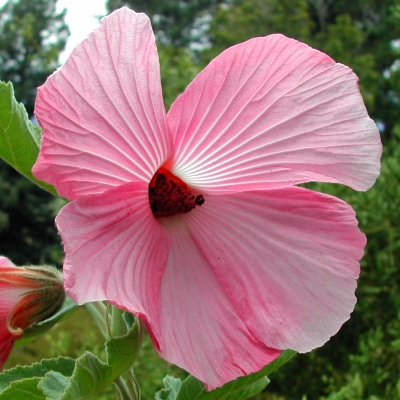Australian Pink Hibiscus
Germinating the seeds Plant your seeds when you receive them for best germination. Getting started -- Rub the seeds across sandpaper or an emery board several times, and then soak them in water for 24 hours (not more than 48 hours). Use a well-draining soil, such as 2 parts potting soil with 1 part perlite or sand. An alternate mix is equal parts of coir fiber and perlite. Fill small containers about 2-3 inches tall (6-8 cm), place a seed on top, and bury about 1/4 inch deep (1 cm). Add water so the soil is uniformly moist. For me, they sprout within 1 to 2 months when kept about 65-77 degrees (18-25°C) during the day, and a little cooler at night. Avoid letting them above 80°F (27°C) for prolonged periods. I recommend placing a minimum/maximum thermometer near the pots. If you place the pots in a propagation dome to maintain moisture, keep it open slightly to let in fresh air. Once they sprout, move them to bright, filtered light. After a few weeks, you can give them some direct sun, but avoid strong afternoon sun the first 2 months. Growing onward... Climate -- It comes from New South Wales in Australia, where temperatures are moderate year-round and nights are cool. I have no information on how it will do in very warm conditions, so consider it experimental in areas that regularly get above 85 degrees F (29°C), especially if nights are warm (above 65°F / 18°C). It can handle an occasional, light frost, but it’s best to protect it from all frost. Over about 40% humidity is best. Fertilizer -- For the first 2 months, it's best to use liquid fertilizer, like hydroponic fertilizer. Feed at 1/8 the recommended dose. After 2 months you may switch to a granular, general-purpose fertilizer. Avoid using fertilizers that are very high in phosphorous ("bloom" fertilizers). The plant doesn't mind some phosphorous, just avoid very high levels. Repot as needed when the plants grow larger. If you have any questions, feel free to email me. - Jeff Strange Wonderful Things
|
|||||||||


